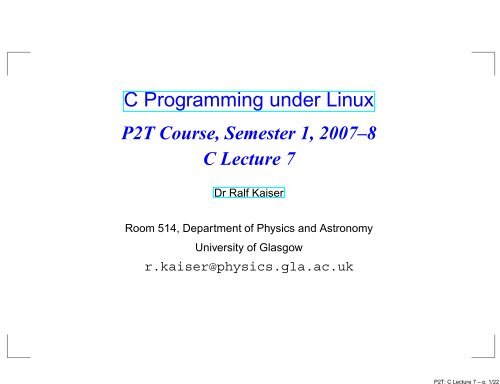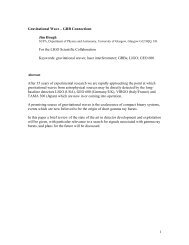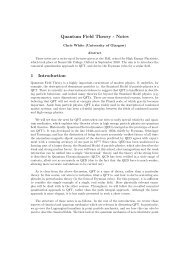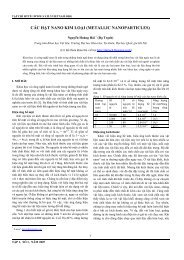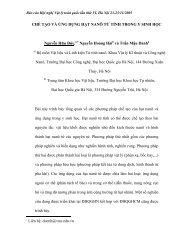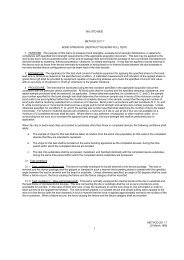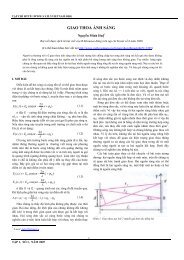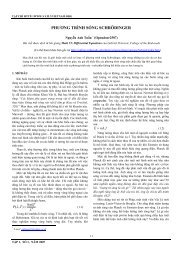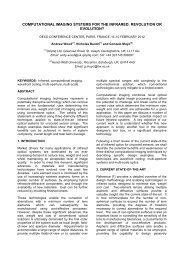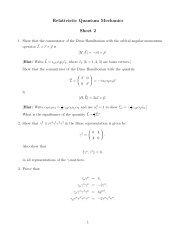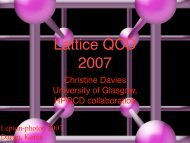C Programming under Linux - University of Glasgow
C Programming under Linux - University of Glasgow
C Programming under Linux - University of Glasgow
- No tags were found...
You also want an ePaper? Increase the reach of your titles
YUMPU automatically turns print PDFs into web optimized ePapers that Google loves.
P2T: C Lecture 7 – p. 1/22C <strong>Programming</strong> <strong>under</strong> <strong>Linux</strong>P2T Course, Semester 1, 2007–8C Lecture 7Dr Ralf KaiserRoom 514, Department <strong>of</strong> Physics and Astronomy<strong>University</strong> <strong>of</strong> <strong>Glasgow</strong>r.kaiser@physics.gla.ac.uk
P2T: C Lecture 7 – p. 2/22SummaryPointers, Pointers, Pointershttp://www.physics.gla.ac.uk/~kaiser/
People and AddressesYou may remember receiving a letter addressed to ’theoccupier’ <strong>of</strong> your flat. This may e.g. have been a reminder toregister for the next election or it may have been a letter fromthe electricity supplier.They clearly meant you, without knowing you name. When youanswered them you would have included your name, e.g. bysigning the letter.Another example would be that instead <strong>of</strong> ’Tony Blair’, i.e. thename <strong>of</strong> the prime minister, the news <strong>of</strong>ten just refer to ’10Downing Street’ and everybody know that this means TonyBlair.More precisely, it means Tony Blair at the moment - in thefuture there will likely be a different name at the same addresswhile Tony Blair will still be around but at a different address.Now comes the relevance to C programming: Any variable has(at a given time) a particular value that is stored at a specificaddress.P2T: C Lecture 7 – p. 3/22
Variables, Values and AddressesEach variable has several attributes that belong to it and thatdefine it:nametypevalueaddressUsually the variable address is something that the system usesimplicitly and that we don’t have to worry about.However, we can also have a variables where the value is amemory address.These variables known as address variables and in C they arecalled pointers, because they point to the location (address) <strong>of</strong>something (the value <strong>of</strong> the variable).Pointers are typical for C, not very intuitive, but very powerful.And they are a bit harder to grasp. That’s why we will spend abit more time on them.P2T: C Lecture 7 – p. 4/22
P2T: C Lecture 7 – p. 5/22Things and Pointers60x10000x1000thingthing_ptrAssume we have a variable called thing. The value <strong>of</strong> thevariable is 6. The address <strong>of</strong> thing is 0x1000.Our pointer thing ptr contains the address 0x1000.Because this is the address <strong>of</strong> thing, we say that thing ptrpoints to thing.
P2T: C Lecture 7 – p. 6/22PointersPointers are linked to a specific type <strong>of</strong> variable. A pointer isdeclared by putting an asterisk (*) in front <strong>of</strong> the variable namein the declaration statement:int thing; /* define a thing */int *thing_ptr; /* define a pointer to an integer */float *result_ptr; /* define a pointer to a float */Different types <strong>of</strong> variables occupy different amounts <strong>of</strong> storagespace in memory (e.g. 1 byte for char and 4 byte for float)The compiler "remembers" the size <strong>of</strong> the variable that thepointer points to.It is a practical convention (but not required) to give pointervariables names with the extension ptr. This helps withkeeping pointers and variables apart. (You may find differentconventions elsewhere, e.g. using p as a prefix.)
P2T: C Lecture 7 – p. 7/22Visualising Pointers1000 1001 1002 1003 1004 1005 1006 1007 1008 1009 1010 1011 1012 1013 10141966 A 3.1415926int a = 1966; char b = ’A’; float c = 3.1415926;int *a_ptr;a_ptr = &a;char *b_ptr;b_ptr = &b;float *c_ptr;c_ptr = &c;1000 1001 1002 1003 1004 1005 1006 1007 1008 1009 1010 1011 1012 1013 10141966 A 3.1415926
P2T: C Lecture 7 – p. 8/22Pointer OperatorsTwo unary operators are used in conjunction with pointers:The operator ampersand (&) returns the address <strong>of</strong> a thing -which is a pointer.The operator asterisk (*) returns the object to which a pointerpoints - i.e. what is found at the address that is the value <strong>of</strong> thepointer.C Codething&thing*thingthing ptr*thing ptr&thing ptrDescriptionthe integer variable named "thing"address <strong>of</strong> the variable "thing" (a pointer)is illegal, the operation is invalidpointer to an integer(may or may not be the specific integer thing)integer variable at the address thing ptr points tois legal, but odd, because it’s a pointer to a pointer
P2T: C Lecture 7 – p. 9/22Pointer Operators cont.int thing; /* declare an integer (a thing) */thing = 4;The variable thing is a thing. The declaration int thing doesnot contain an *, so thing is not a pointer.int *thing_ptr; /* declare a pointer to a thing */The variable thing ptr is a pointer, indicated by the * in thedeclaration (and by the extension ptr).thing_ptr = &thing; /* point to the thing */The expression &thing is a pointer (the address <strong>of</strong> the variablething). This is now assigned to thing ptr.*thing_ptr = 5; /* set "thing" to 5 */The expression *thing ptr indicates a thing, because the * tellsC to look at the data pointed to (an integer in this case), not thepointer itself. We now have set thing to 5. Note that thing ptrpoints at any integer, it may or may not point to the specific variablething.
P2T: C Lecture 7 – p. 10/22Pointer Operators - Exampleprintf using variable and pointer to variable. (thing.c)#include int main(){int thing_var; /* define a variable for thing */int *thing_ptr; /* define a pointer to thing */thing_var = 2; /* assigning a value to thing */printf("Thing %d\n", thing_var);thing_ptr = &thing_var; /* make the pointer point to thing */*thing_ptr = 3; /* thing_ptr points to thing_var so *//* thing_var changes to 3 */printf("Thing %d\n", thing_var);}printf("Thing %d\n", *thing_ptr); /* another way <strong>of</strong> doing the printf */return (0);Output:Thing 2Thing 3Thing 3
P2T: C Lecture 7 – p. 11/22Pointers as Function ArgumentsC passes parameters to a function using call by value, i.e. theparameters go only one way into a function.Not the parameter itself, only it’s value is handed to thefunction. The only result <strong>of</strong> a function is a single return value.Pointers can be used to get around this restriction.Instead <strong>of</strong> passing a variable to a function (which would onlypass the value <strong>of</strong> the variable) we pass a pointer to the function(which passes the value <strong>of</strong> the pointer).The value <strong>of</strong> the pointer is an address, the address <strong>of</strong> thevariable that we can change now.The parameter handed to the function (the address) is notchanged, but what it points to (the value <strong>of</strong> the variable at theaddress) is changed.
P2T: C Lecture 7 – p. 12/22Pointers as Function Arguments - ExampleFunction that demonstrates the use <strong>of</strong> pointers to pass parametersthat can be changed (call.c).main calls the functioninc count to increment thevariable count.#include void inc_count(int *count_ptr){++(*count_ptr);}int main(){/* number <strong>of</strong> times through */int count = 0;}while (count < 10){inc_count(&count);printf("%d\n", count);}return (0);Passing count would onlypass it’s value (0).So the address &count ispassed instead, as aparameter specified as apointer to an integer (int*count ptr).Note that the parameter (theaddress) is not changed, butwhat it points to (the value atthe address) is changed.
P2T: C Lecture 7 – p. 13/22const PointersPointers can be constant, but this is a little tricky, becauseeither we can have a constant pointer or a pointer to aconstant.const char *answer ptr = "Forty-Two";does not mean that the variable answer ptr is a constant, butthat the data pointed to by answer ptr is a constant. Thedata cannot change, but the pointer can.If we put const after the * we tell C that the pointer isconstant, e.g. char *const name ptr = "Test";.In this case the pointer cannot be changed, but the data itpoints to can.Finally, if we really want to, we can create a const pointer to aconst variable:const char *const title ptr = "Title";.
P2T: C Lecture 7 – p. 14/22Pointers and ArraysC allows pointer arithmetic (addition and subtraction). Becausethe elements <strong>of</strong> an array are assigned to consecutiveaddresses, this allows to navigate an array.C automatically scales pointer arithmetic so that it workscorrectly, by incrementing/decrementing by the correct number<strong>of</strong> bytes.If we create an array and a pointer to it’s first elementchar array[5];char *array ptr = &array[0];we can then refer to the n th element <strong>of</strong> the array array[n] as*(array_ptr+n).The brackets () are important; (*array_ptr)+n is the same asarray[0]+n, not array[n].C provides a shorthand for dealing with arrays:array ptr = array; instead <strong>of</strong> array ptr =&array[0];
P2T: C Lecture 7 – p. 15/22Pointers and Arrays - ExampleScanning an array using array index and pointer increment incomparison (ptr2.c, ptr3.c).#include int array[] = {9, 8, 1, 0, 1, 9, 3};int index;int main(){index = 0;while (array[index] != 0)++index;}printf("%d elements before zero\n",index);return (0);#include int array[] = {9, 8, 1, 0, 1, 9, 3};int *array_ptr;int main(){array_ptr = array;}while ((*array_ptr) != 0)++array_ptr;printf("%d elements before zero\n",array_ptr - array);return (0);The index operation required for the while loop on the left sidetakes longer than the pointer dereference on the right side.
P2T: C Lecture 7 – p. 16/22Passing Arrays to FunctionsYou may want to pass an array to a function. If you do so, C willautomatically change the array into a pointer - because youcan only hand single values over to a function. In this case theaddress <strong>of</strong> the first element <strong>of</strong> the array.If you want your function to know how many elements the arrayhas, you may want to pass on the number <strong>of</strong> elements as asecond (integer) variable.int some_function(int *data_ptr, int nelements);If you pass a single variable to a function you only pass a copy<strong>of</strong> the variable’s value - so the original variable cannot bechanged. This is different if you pass an array. Because youare passing it as a pointer, the code in the function is workingwith the actual array elements.
P2T: C Lecture 7 – p. 17/22Passing Arrays to Functions - ExamplePassing an array to a function and initialising it (init-a.c).#define MAX 10void init_array_1(int data[]){int index;}for (index = 0; index < MAX; ++index)data[index] = 0;int main(){int array[MAX];void init_array_1();void init_array_2();/* 4 ways <strong>of</strong> initializingthe array */void init_array_2(int *data_ptr){int index;}for (index = 0; index < MAX; ++index)*(data_ptr + index) = 0;}init_array_1(array);init_array_1(&array[0]);init_array_1(&array);init_array_2(array);return (0);When passing an array to a function, C will automatically changethe array into a pointer. In fact, C will issue a warning if you put a &before the array, i.e. as in version 3.
Pointers-to-PointersPointers are variables whose value is an address.According to the type <strong>of</strong> variable at the address, we can havee.g. a pointer-to-integer or a pointer-to-float.Like any other variable, also pointers are stored at a specificplace in the computer’s memory - they also have an address.We can therefore define a variable that has as it’s value theaddress <strong>of</strong> a pointer - a pointer-to-pointer.int x = 12; /* x is an integer variable with value 12 */int *x_ptr = &x; /* x_ptr is a pointer to the integer x */int **ptr_to_ptr = &x_ptr; /* ptr_to_ptr is a pointer to a pointer *//* to type int */Note the double indirection operator (**) when declaring thepointer-to-pointer.There is in principle no limit to the level <strong>of</strong> multiple indirection -you could point and point and point and point. But there is noreal advantage to anything with more than two levels <strong>of</strong>pointing.P2T: C Lecture 7 – p. 18/22
P2T: C Lecture 7 – p. 19/22Arrays <strong>of</strong> PointersBecause pointers are one <strong>of</strong> C’s data types you can declareand use arrays <strong>of</strong> pointers.One possible use for this is an array <strong>of</strong> pointers to type char,aka an array <strong>of</strong> strings.It’s much easier to pass an array <strong>of</strong> pointers to a function thanto pass a series <strong>of</strong> strings.In fact, you are <strong>of</strong> course passing a pointer to the function - thispointer is a pointer-to-pointer.This actually is one <strong>of</strong> the main applications <strong>of</strong> multipleindirection.
P2T: C Lecture 7 – p. 20/22Arrays <strong>of</strong> Pointers - ExamplePassing an array <strong>of</strong> pointers to a function (p2p.c).#include void print_message(char *ptr_array[], int n) {int count;for (count = 0; count < n; count++){printf("%s ", ptr_array[count]);}printf("\n");}int main() {char *message[9] = {"Dennis", "Ritchie", "designed", "the", "C","language", "in", "the", "1970s"};print_message(message, 9);return (0);}Output:kaiser@npl03:˜/linuxc/oreilly/pracc/p2p> p2pDennis Ritchie designed the C language in the 1970s
P2T: C Lecture 7 – p. 21/22Pointers to FunctionsA pointer holds an address. This may be the address <strong>of</strong> avariable or the address <strong>of</strong> the first element <strong>of</strong> an array - thecases we looked at so far.However, a pointer may also hold the starting address <strong>of</strong> afunction, i.e. the address where the function is stored inmemory.Pointers to functions provide another way to call functions.The general form (and some examples) for the declaration <strong>of</strong> apointer to a function:type (*ptr_to_func)(parameter_list);int (*func1)(int x);char (*func2)(char *p[]);The parentheses around the function name are necessarybecause <strong>of</strong> the relatively low precedence <strong>of</strong> the indirectionoperator (*).
P2T: C Lecture 7 – p. 22/22How not to Use PointersPointers in themselves are already confusing enough.However, the combination <strong>of</strong> pointers with increment anddecrement operators (++/–) can easily make matters worse.Have a look at these lines <strong>of</strong> code as examples <strong>of</strong> how not touse pointers:data_ptr = &array[0]; /* Point to the first element <strong>of</strong> the array. */value = *data_ptr++; /* Get element #0, data_ptr points to element #1.*/value = *++data_ptr; /* Get element #2, data_ptr points to element #2.*/value = ++*data_ptr; /* Increment element #2, return it’s value *//* Leave data_ptr alone. */While it’s not impossible to figure out what is going on, it is notthe point <strong>of</strong> programming to provide challenging little puzzlesto the programmers that have to look at your code in the future.Here is another bad example:void copy_string(char *p, char *q){while (*p++ = *q++);}


